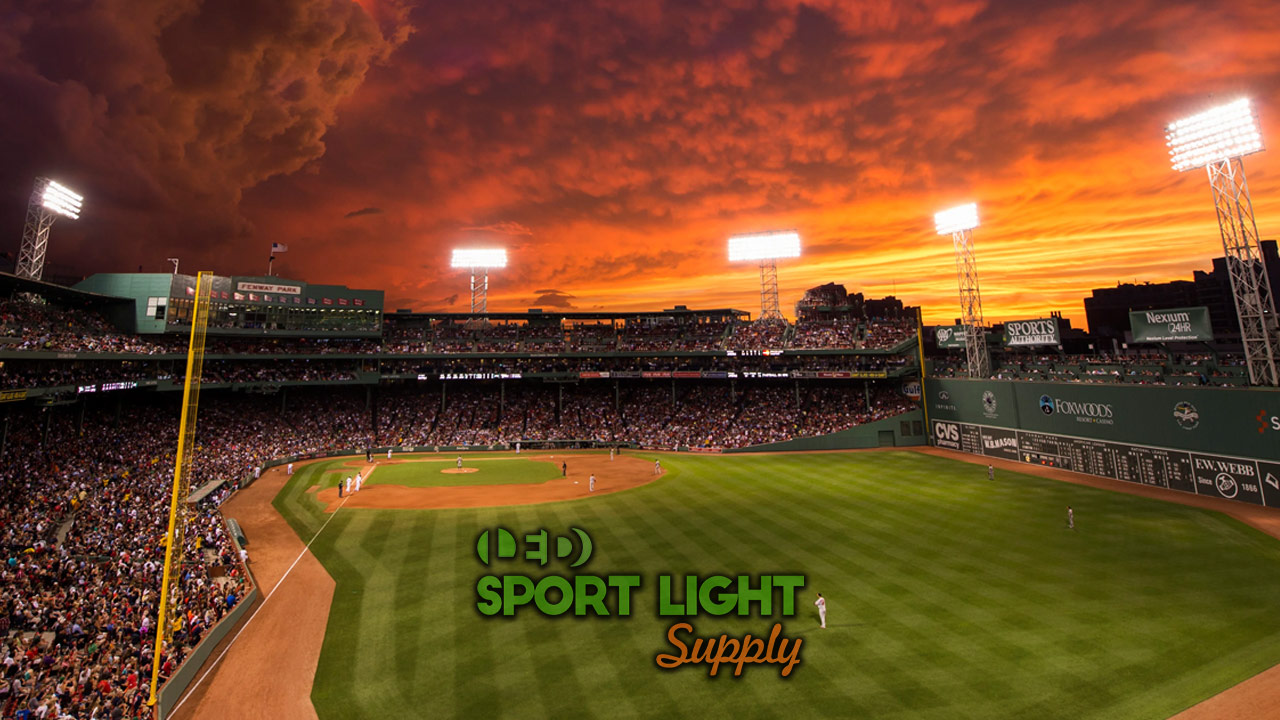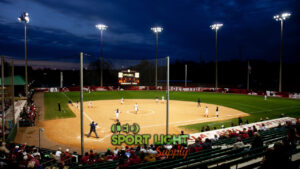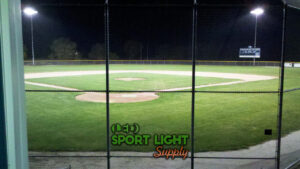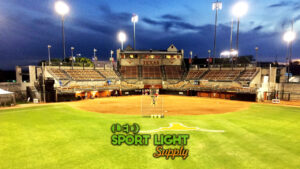Each baseball field follows a precise lighting design. Whether it is a stadium, high school, or college facility, an adequate light level must apply. Then again, the standard LED flood light optics might not be enough. Today, sports venues use LED lights according to the current association’s specification.
Here is what you need to know to follow your high school baseball field lighting requirement. But first, it is necessary to point out what the high school lighting standards are about. We will also see how to fulfill the lighting requirement in a high school stadium in the following parts. In the end, a baseball field lighting buyer’s guide will reveal what you need to look out for a great deal.
What are the high school/college baseball field lighting standards?
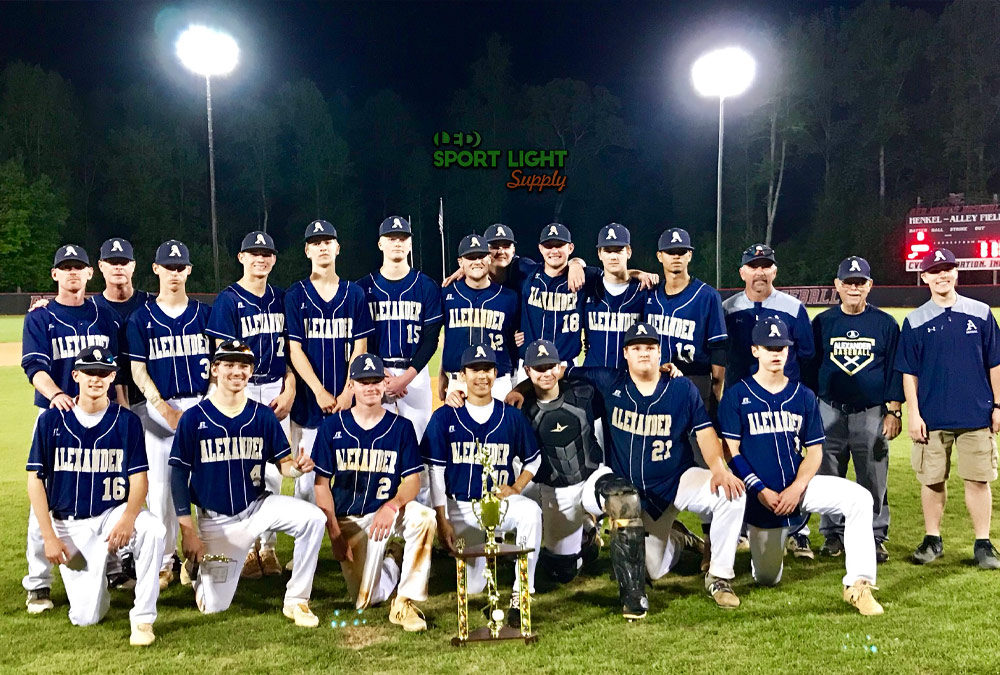
You might wonder if the lighting standard changes for baseball or softball activities. Well, the short answer is no. Careful planning must include a lighting layout for both baseball and softball fields. In detail, both the high school baseball diamond the softball field need high-quality lighting.
Mostly, the two main factors in creating a standardized brightness are:
- the light poles
- the rules and/or each lamp specification
Every single related topic concerning these two factors will be discussed. Let us take the time to understand each part of the baseball field lighting standard.
High school baseball field light pole standard
1. High mast pole location (lighting layout)
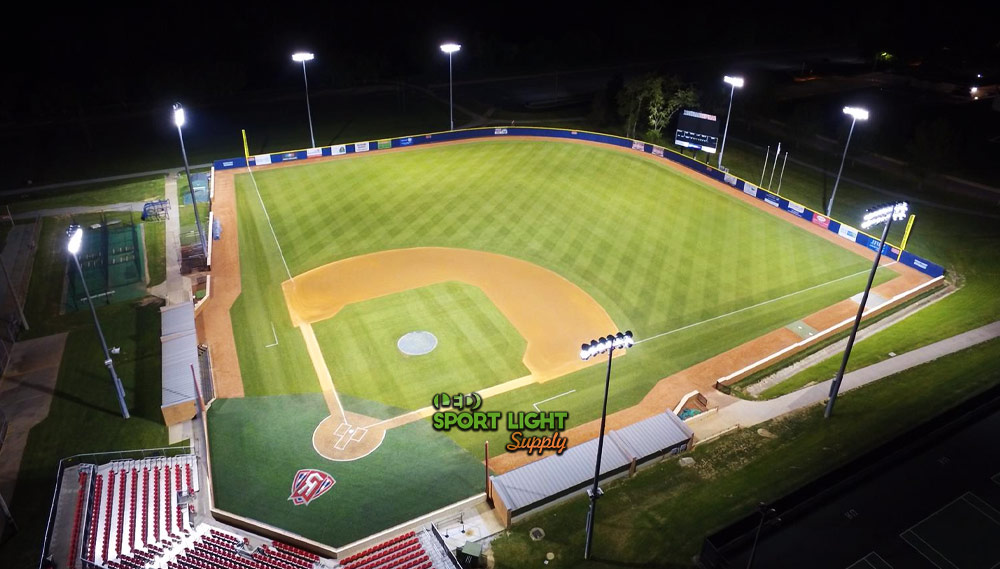
The light pole locations influence the playability. So, three standard lighting layouts are commonly used to provide enough illumination.
The main goal is to reach a minimum light requirement measured in footcandles. Also known as lux level. Without the correct position, no flood light can make the field enough bright and safe for the ballplayers.
No light pole is inside the baseball diamond or softball field. First, experts recommend the areas where the light poles should be. Then, they proceed to calculate the necessary light output according to their actual locations.
2. Number of poles
The basic configuration uses a 4-pole design for a small playing area. Namely, a pitch with a radius below 250 feet. Two light poles are at each side of the home plate. As you can imagine, the other two lies somewhere near the first and third base.
In the 6-pole layout, two high masts light up the outfield. This design is ideal for ball fields with a radius greater than 250 feet.
Lastly, the 8-pole design adds two more high masts to illuminate the outfield in big stadium fields. These athletic fields have a radius of 320 feet or more.
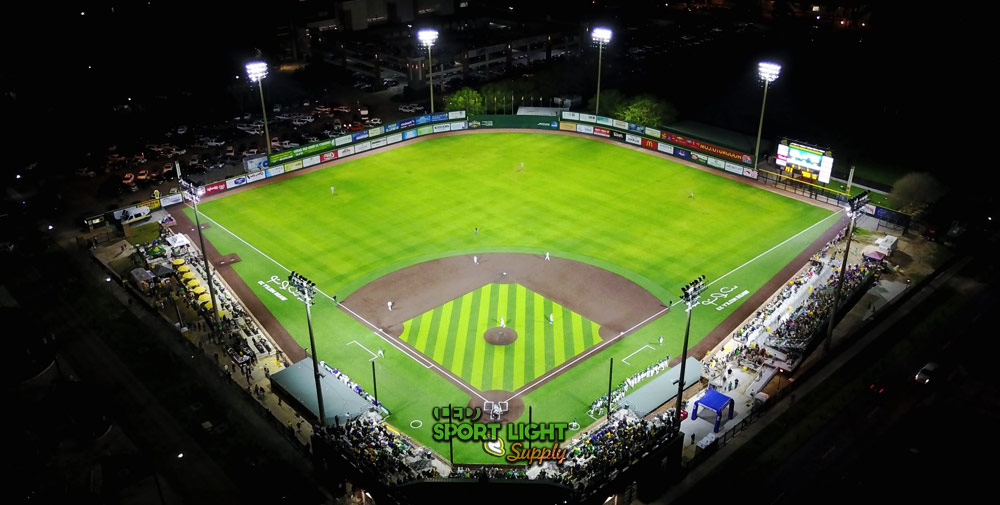
3. Pole height
The pole heights vary because the flood lights on top of them must be installed at a suitable angle. In detail, the vertical angle of the light fixtures determines the quality and quantity of both wanted and unwanted brightness. In fact, incorrect angles can cause problems such as glare or light pollution.
Each LED fixture should aim at the infield at a 25-degree angle. Instead, a 21-degree vertical angle is enough to illuminate the outfield. Later, you will read more about beam angles. But remember that the vertical aiming angle is the standard upon which choosing fixtures with different beam angles.
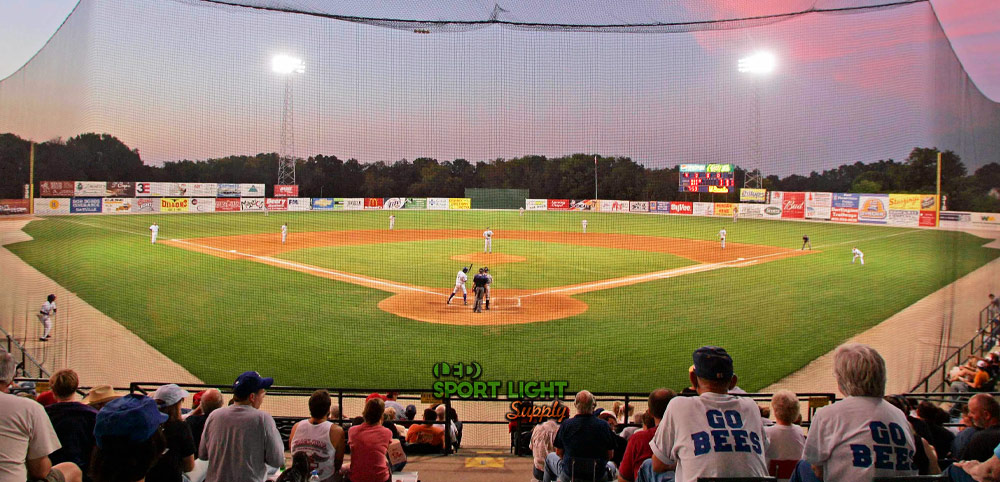
4. Pole material
The strength of the light poles is of uttermost importance. After all, the baseball diamond will host many games for several years. So, the pole material must stand the test of time and resist bad weather conditions.
Every high school sports facility or stadium needs reliable high masts built to a high specification. Otherwise, they could lean or bend.
A licensed engineer must ensure the strength of the foundation with certified documentation. Commonly, the pole designer will use galvanized steel poles to support the lights.
The manufacturer should also provide a warranty and guarantee.
5. Lightning protection
A lightning protection system should protect the flood lights. Of course, the NFPA 780 standards require the use of every precaution to safeguard everyone and everything from lightning strikes.
As a matter of fact, the ground could not ensure an adequate lightning energy dispersion. At the same time, the lightning strike could damage the electrical system. A dissipation array system or lighting rod must hence be in place on top of each high mast.
Supplemental grounding electrodes and other secondary conductors might be necessary. Of course, the high school baseball field light poles must pass the lightning grounding system test.
6. Lighting control system (DMX/DALI)
The DMX protocol is a tech that manages the flood lights. In detail, it uses the XLR connector, which can be 3-pin or 5-pin. The 3-pin connector controls up to 512 channels, while the 5-pin connector up to 1024 channels.
In plain words, it lets you adjust the brightness, color temperature, and other LED features efficiently. It is not uncommon to find the DMX protocol even in a college stadium.
DALI is another popular lighting control system. On the positive side, it allows you to manage the entire lighting system by associating an address to each luminaire. Besides, you can group the lighting fixtures or isolate some of them from the rest of the system. For example, it is possible to adjust the light intensity of specific groups or individual lighting products.
Baseball/softball field lighting requirement in high school
1. Lux & footcandle (brightness) requirement
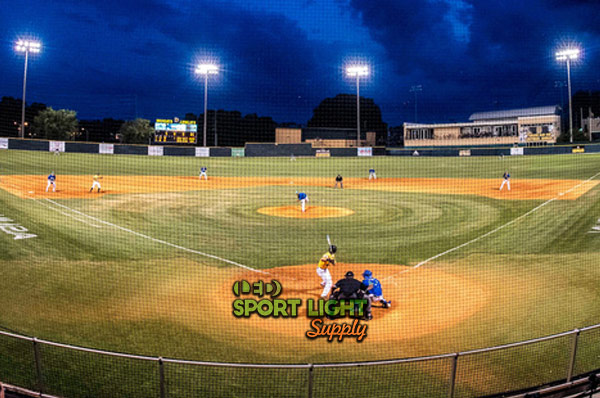 Before installing the lights, the stadium owner should consult a lighting designer or engineer. The level of play determines the recommended light levels. Every high school, college, or sports facility must comply with the regional or national standard.
Before installing the lights, the stadium owner should consult a lighting designer or engineer. The level of play determines the recommended light levels. Every high school, college, or sports facility must comply with the regional or national standard.
Here are the minimum criteria for rec or Little League both in footcandles and lux levels. Baseball and softball fields must provide:
- 30 footcandles (fc) in the infield and 20 fc in the outfield.
- 540 lux in the infield, and 320 lux in the outfield
Of course, the correct amount depends on the level of competition. In fact, televised games need standardized light conditions for recording purposes. For example, high school competitions require up to 50 fc (infield) and 20 fc (outfield).
2. Light uniformity
At the planning stage, you need to ensure the quality of lighting. So, you need to measure the lighting uniformity. To do that, the three essential factors are:
a) The uniformity ratio
That is, a minimum of 0.6 to a maximum of 0.7 for the infield and 0.4 to 0.5 for the outfield.
b) The uniformity gradient
In short, a uniformity sampling of adjacent points on the baseball field. As you can imagine, no one wants abrupt lux change from one point to the next. Suppose you have 200 lux in a spot and 500 lux just feet away. In this case, the uniformity gradient exceeds the maximum value.
c) The coefficient of variation
A mathematical ratio is used to calculate the standard deviation. Basically, it ensures that, on average, all the lux values in the paying area provide adequate illumination.
3. Color temperature
Even if the brightness level is the most crucial factor, the color temperature of the lights matters as well.
LED lights can emit different color temperatures, measured in Kelvin. For example, the warm light ranges from 4,500 K to 5,500 K. In detail, the light has a daylight color appearance. The cool light ranges from 5,500 K to 6,500 K with a bluish-white hue.
Below 4,500 K, light tends to be too yellowish, so no one uses this color temperature. Similarly, a color temperature above 6,000 K might be too bluish.
4. CRI & TLCI
One of the main functions of lighting is creating a highly emotional atmosphere for televised events. CRI is an essential design element. To specify, CRI stands for color rendering index. But when it comes to broadcasting, the more specific TLCI value ensures the best results.
In the baseball diamond, the light must have an excellent color rendering. Otherwise, it could not offer stable color temperatures and a high color rendering index.
The Television Lighting Consistency Index provides a standardized method to ensure better color accuracy for broadcasting. In brief, reliable light sources have a TLCI above 85 on a scale of 100. Equivalent CRI values in the product specification must be 95+.
5. Light spill
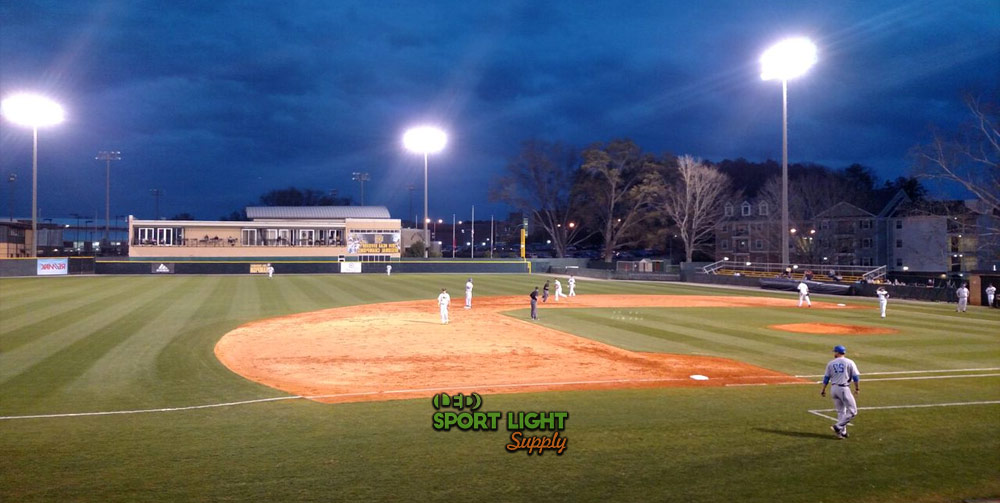
I already mentioned light pollution. To begin with, this is a pressing matter. Especially for most high school and college facilities because they are located in residential areas.
A light pollution design should take care of this problem right away. In fact, the standard stadium lighting can negatively affect the nearby drivers’ capacity behind the wheel.
Each light fixture should aim at the baseball stadium or softball field at the recommended angles and include shielding. Be sure to follow your local planning committee’s ordinance on this matter.
How to evaluate the lighting requirement in a high school baseball stadium?
After buying and installing the lights, here is what you need to do. The baseball field owner or high school/college representative should do the same testing as well. First of all, it is necessary to check if the lighting system follows the relative requirement.
You can measure and record the lux level at different points on the baseball field with the use of a lux meter. In detail, you do this by following the light level grid point layout for your athletic field. The more points recorded, the more precise the results.
Then, you need to verify the regional or national standard by holding the lux meter just above 36 inches in the center of each grid layout square. In this way, you get the average lux or footcandle value. Plus, the uniformity ratio by dividing the highest and the lower readings in both the infield and outfield.
Baseball field lighting buyer’s guide
1. Luminous efficacy
Whether you need to buy or replace a flood light, you should pay attention to the lumen watt ratio first. A 150 lm/W (or higher) ratio is the minimum recommendable value you require.
The lumen is nothing more than the unit of measurement of the luminous flux. More precisely, it indicates the quantity of light emanating from the light source. You find both wattage and lumens on the packaging in the specification section.
2. Beam angle
Remember to consider that a large beam angle is great for the short-range areas. On the other hand, a small beam angle for long-range use only to handle a broad area.
The larger the beam angle, the wider the illuminated space. Most LED flood lights have a 70-120 degree angle. If you need a narrower angle, search for a spot light.
Place the fixtures so as to maintain the standardized vertical angle we discussed. Then, use shielding to cover o minimize any light spill.
3. Life span
Of course, you should get the most performing light fixtures. From a technical point of view, LED lights last longer than any other lamp types.
A LED flood light can work for more than 150,000 hours. Above all, they are perfect to always deliver reliable light intensity.
Furthermore, LED lamps protect the environment because they do not contain any type of toxic element inside them. Instead, metal halide lights have mercury. And halogen lamps emit ultraviolet radiation, which is bad for baseball players and everyone else’s health.
4. Color temperature
The standard stadium flood light has a cool, bright light. If you want to provide natural lighting, choose 5,500 K bulbs for your layout.
Remember that above 7,000 K, the color temperature is too cold and bluish. For most people, it feels unnatural and could cause discomfort.
Warmer hues tend to be more pleasing to the eye. Plus, they ensure a comfortable vision every time the brightness level is correctly standardized.
5. Heat dissipation system
Here is a pro tip. Before you buy, check which heat dissipation device the light fixture uses. If you cannot find an answer, ask the seller.
A good heat dissipation system can significantly extend the life span of LED sports flood light. To explain, overheating causes every bulb to consume faster. But the addition of a heat sink reduces this issue.
LED lights do not heat as much as other types of lamps. But continual use can lead to heat peaks. Especially during the warmer seasons. So, a great heat sink is indispensable.
6. Light shield
If you want to prevent light pollution problems, you need to use shielding. So, pick a model with a light shield.
You can leave the barn door attached to the edges of the flood lights in order to reduce spill light. Moreover, you can use more barn doors to create more focus and optimize their use.
If you are buying them as accessories, make sure you get the right size or type of shielding for your lights.
7. Customized installation bracket
A little-known part is the installation bracket, which is used to mount your lights on the light pole. To specify, it is similar to an adapter. You place it between the flood lights and the light pole.
Some manufacturers can customize this component for free, but others cannot. As you can imagine, it does not feel great to find out that you need to change the installation bracket when you need to replace a flood light. So, make sure you can mount or customize the installation brackets.
8. Weight of luminaries
Before you buy anything, refer to the engineer’s high mast specifications. Some light pole might not tolerate heavy flood lights. So, careful planning must take into account the weight of the luminaries.
Over the year, snow and ice could alter the overall weight. The professional engineer considers these factors and must include a maximum load per pole. In case you do not find this data, ask your lighting engineer or designer.
Why do we need to fulfill the high school softball stadium lighting standard?
1. It is better for students’ vision
Softball players require adequate lighting to sustain its fast pace of action. After all, it is even faster than baseball.
The base runner must sprint and follow what the opponents are doing. So, poor lighting could lead to injuries and accidents.
Similarly, slow-pitch softball requires more focus to hit the ball correctly. The same goes for the pitcher.
2. Create an atmosphere
Without any doubt, games pave the way for energetic fans in the stands. Then again, light instills a sense of welcome, well-being, and safety.
Notably, correct lighting of the baseball field captures the attention of both local and at home spectators.
Not surprisingly, the lighting requirement includes tips to also enhance everyone’s enjoyment. For example, the connections must be buried deep enough to reduce to zero the risk of tripping over cables left exposed.
3. Safety and security
When the nights get longer again, illuminated entrances and paths also offer protection against thieves. Where you see light, the danger of being assaulted is much lower. Especially if the building and entrance areas are well lit.
It is therefore advisable to install light sources also in the outdoor area of the stadium. Preferably, combined with a timer that automatically turns the light on and off at regular intervals. Alternatively, using sensor motion LED lights increase both safety and security measures.
Conclusion
The high school baseball field lighting requirement can vary from state to state. Generally speaking, most standards rely on national guidelines and specifications.
Before you can install the LED flood light system, you need to create a lighting layout. Then, you must meet the required lux level. Plus, the standardized light uniformity.
The recommended softball light features explained in the last two sections can help you achieve optimal results.

